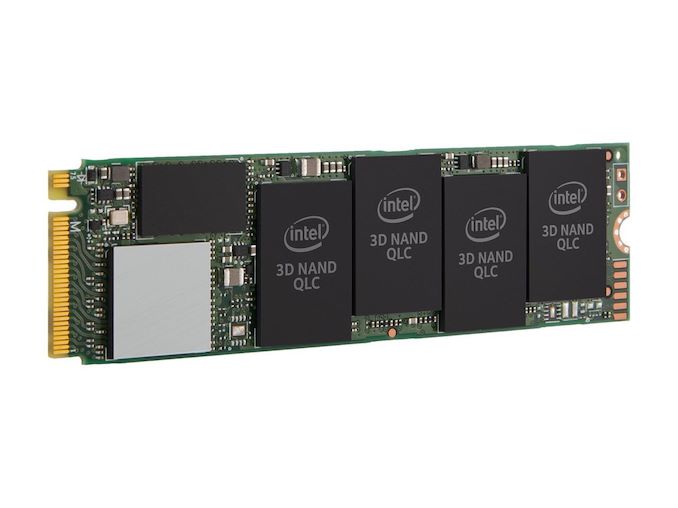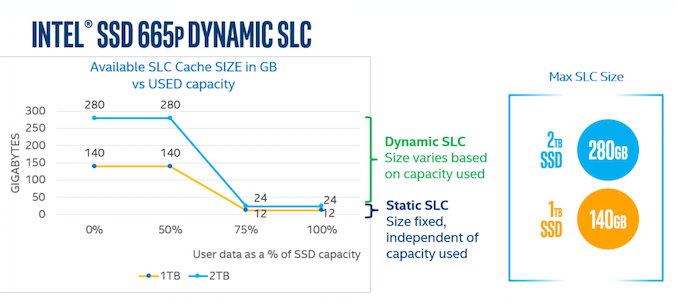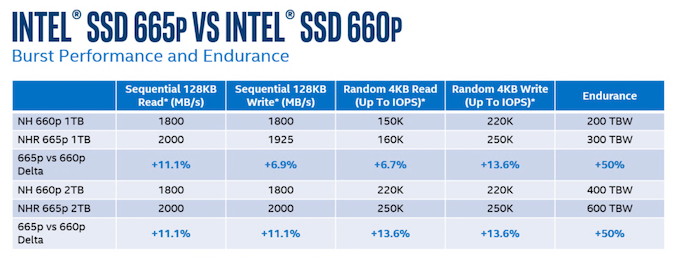Intel Releases SSD 665p: Second-Gen QLC
by Billy Tallis on November 25, 2019 3:00 PM EST
Two months after being announced, the Intel SSD 665p is set to be released today. The 665p is the successor to the 660p, the most (only?) successful consumer SSD based on four bit per cell (QLC) NAND flash memory. The 665p makes minimal changes to the design of the 660p; the most important of which is switching from Intel's 64-layer 3D QLC NAND to their newer 96-layer 3D QLC NAND.
Intel claims to have the first 96L QLC in production, though Western Digital has already announced they are shipping products using their own 96L QLC (albeit not in internal SSDs yet). It appears that production of Intel's 96L has not ramped up much yet, because today we are only getting the 1TB SKU of the 665p—the 2TB model won't be arriving until Q1 of 2020. The 512GB model won't be happening at all. The 512GB 660p was much more susceptible to the performance downsides of QLC NAND than the larger models, and given the pricing of 512GB-class TLC-based drives, it's reasonable for QLC product lines to start with a minimum of 1TB.
The 665p continues to use the Silicon Motion SM2263 NVMe SSD controller, with a small DRAM cache and a massive variable-size SLC cache:
The switch to 96L QLC has enabled minor performance improvements. The basic performance specs have been boosted by up to 13.6%, which isn't enough to noticeably impact real-world use cases. This is still an entry-level NVMe SSD that could get by just fine with a mere PCIe 3.0 x2 connection even though it supports an x4 link. As usual, these specs are for burst performance where the SLC cache is in use; post-SLC write speeds are still slower than what any vendor wants to put on a spec sheet. When Intel announced the 665p in September, they showed CrystalDiskMark results for the 660p vs the 665p that cast the 665p in a much better light, but their numbers for the 660p were suspiciously low.
Much more important than the performance changes is the write endurance boost the 665p brings compared to the 660p. Both capacities of the 665p have 50% higher rated write endurance than the 660p, bringing them up to about 0.16 drive writes per day (DWPD) from the 660p's 0.11 DWPD. This is still a lot lower than the 0.3 DWPD that is typical for low-end consumer SSDs that use TLC NAND, but the increase does show that Intel's feeling more confident in their second generation of QLC.
Looking to the future, Intel's next step after 96 layers will be to 144 layers. That generation of 3D NAND will be QLC-only at first and will arrive in the second half of 2020. So Intel may end up doing a second refresh of this SSD about a year from now before this product segment is ready to move to PCIe 4.0.
Newegg is currently selling the 1TB 660p for $82.99 as part of their Black Friday sales, making it one of the cheapest SSDs on a per-GB basis, in any form factor, interface or capacity. We're not expecting the 665p to debut at such a low price, but after the holiday sales are over the 665p will probably overtake the 660p as the most affordable NVMe SSD.
Intel is not sampling the 1TB 665p for review at this time, but we've asked for a review sample of the 2TB model when it becomes available.
Related Reading:
- Intel Announces SSD 665p: Denser, Faster QLC NAND
- Intel Shares New Optane And 3D NAND Roadmap - Barlow Pass DIMMs & 144L QLC NAND in 2020
- Western Digital Begins Shipments of 96-Layer 3D QLC-Based SSDs, Retail Products
- Biostar Launches M700 SSDs: Entry-Level PCIe SSDs
- Team Group Unveils MP33 SSDs: Entry-Level PCIe Drives
- Best SSDs: Holiday 2019












28 Comments
View All Comments
vladx - Monday, November 25, 2019 - link
Wow hope the 2TB will be closer to $150.danielfranklin - Monday, November 25, 2019 - link
While i hate seeing these ship is high-end laptops as primary SSDs as well as being sold without letting the end users know what they are getting, im really starting to see the place in the market for them.Only issue if really you cant get anywhere near filling them, therefore you might as well buy a TLC drive unless you really need the ability to blow out space in the short term. Therefore the practical market is quite small for them. The realistic market seems to be everything because M.2 and SLC cache speed is apparently everything is marketing and semi technical users * rolleyes*
extide - Monday, November 25, 2019 - link
I really want one for use as a Steam/Games drive. Seems perfect for large amounts of data that won't change much but where it's nice to have ~quick read speed. Should perform pretty well even mostly full. I'd like for them to come out with a 4TB version tho. Will probably pick up a 2TB one next year when the 665 2TB comes out tho.Slash3 - Monday, November 25, 2019 - link
This and being used as a light OS/app drive are probably the best uses for a 660p. Few sustained writes, but fast enough during typical operation where the SLC cache isn't exhausted (even when near full). The other application is in laptops, as the 660p has extremely good power efficiency, especially at idle with Active State Power Management enabled (near 0W).They're not bad drives at all, but they are definitely not the weapon of choice if you're dealing with large files (eg, 4K video editing, archiving or drive cloning) on a regular basis. In these scenarios they'd ultimately be outclassed by even an old SLC/MLC/TLC SATA SSD.
Amandtec - Tuesday, November 26, 2019 - link
It is the cheapest Toyota on the market. You are complaining it doesn't perform well against the Ferrari.Slash3 - Tuesday, November 26, 2019 - link
It's not appreciably less expensive than a Phison E12 solution (~10%). We're comparing a Mazda to a Honda. They both make concessions to meet a price point, and should be weighed accordingly to their individual strengths and weaknesses.jabber - Wednesday, November 27, 2019 - link
Yeah as a local IT support guy who gets to work on masses of 5400rpm HDD laptop junkers, I'll take ANY SSD over spinning rust any day of the year. No contest.Some of you have become too spoilt and forget what the real world is like out there.
"Ohh boo hoo hoo it doesn't run at 3500MBps!"
Big deal. Go back to 5400rpm/75MBps and massive latency then swap back to a standard SATA SSD and feel the boost.
Spunjji - Wednesday, November 27, 2019 - link
Generally I'm in agreement, but it's worth noting that under certain circumstances the write (and/or mixed read/write) speeds on these QLC SSDs can drop to 7200rpm notebook HDD levels.jabber - Wednesday, November 27, 2019 - link
Still not a problem for 99% of the ordinary domestic folks who might have them. The don't do much 'big data'. Trust me.DanNeely - Tuesday, November 26, 2019 - link
If it could come close to saturating an x4 link for sequential IO I'd agree; but topping out at x2 speed is a rather large bottleneck I'd prefer to avoid even for quasi-readonly storage.